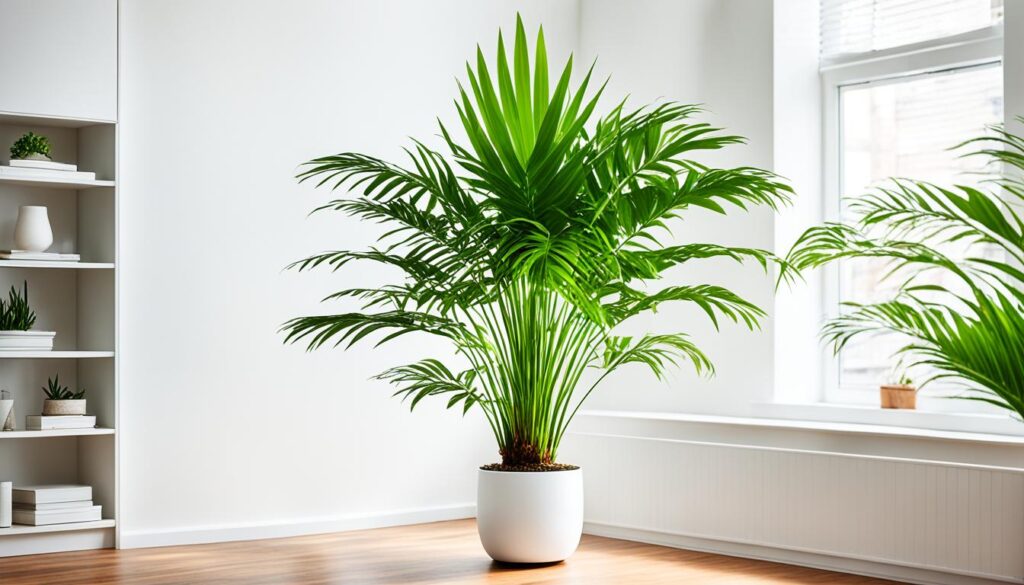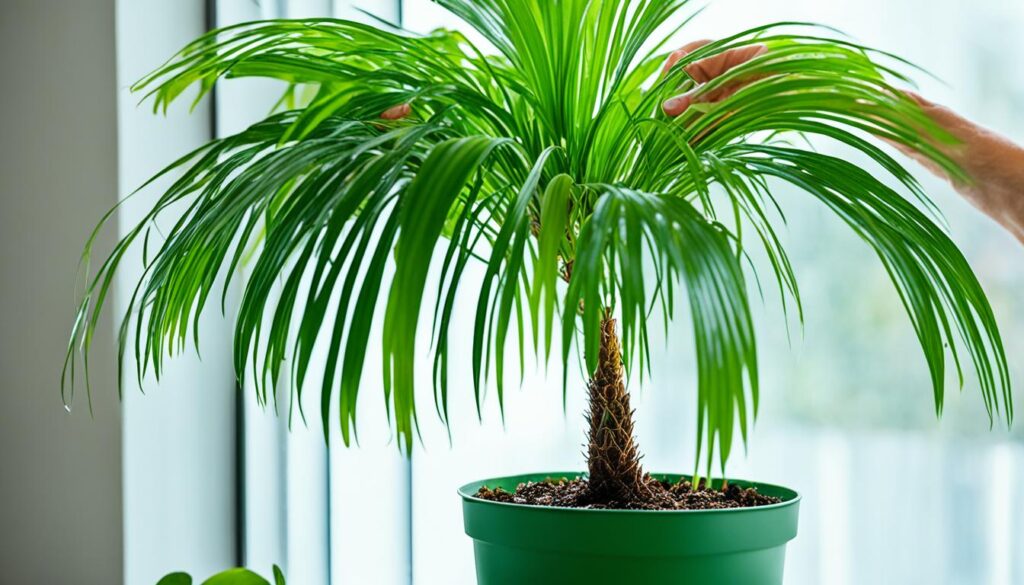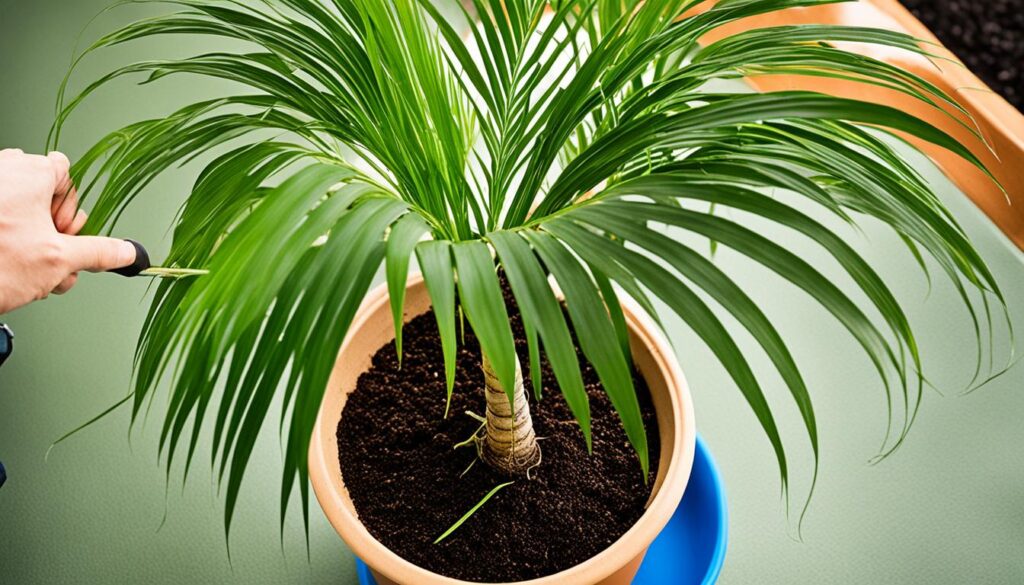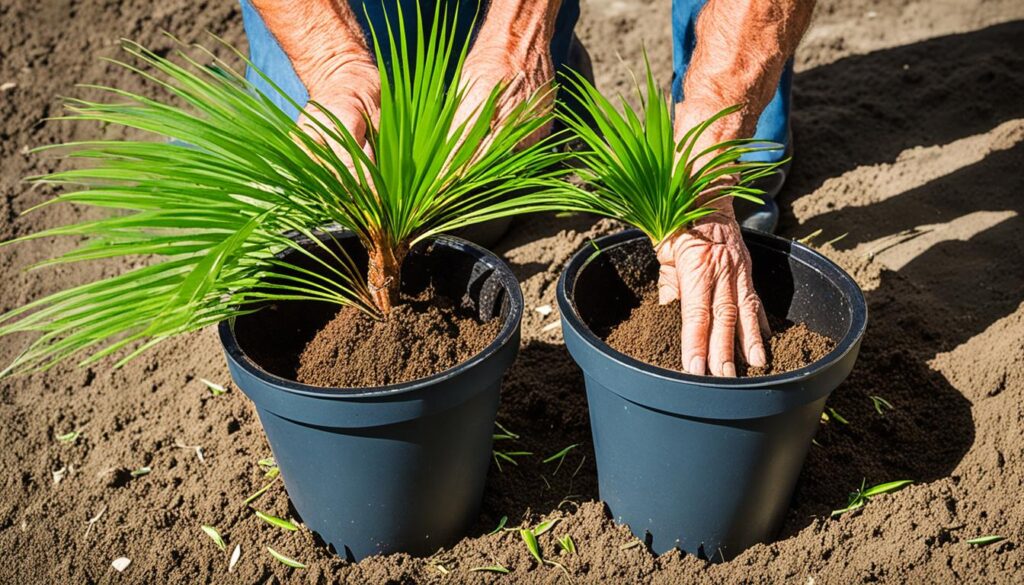Did you know the Areca Palm is a beautiful plant that also cleans the air? It removes pollutants, making your home healthier. If you want to grow a healthy Areca Palm, you’re in the right spot.
In this guide, I’ll tell you everything you need to know to care for an Areca Palm. You’ll learn about its looks, light needs, how to water, feed, pot, and more. I’ll also share how to handle pests and diseases.
This guide is for anyone who loves plants, whether you’re new or experienced. With the Areca Palm, you can make a green and lively place in your home.
Key Takeaways:
- Learn how to grow and care for the Areca Palm, an attractive and low-maintenance indoor plant.
- Discover why the Areca Palm is beloved for its air-purifying properties and pet-friendly nature.
- Find out about the Areca Palm’s appearance, light and watering requirements, fertilization techniques, potting tips, propagation methods, and maintenance strategies.
- Explore effective ways to deal with common pests and diseases that may afflict the Areca Palm.
- Get insider tips for maintaining and overwintering your Areca Palm, as well as insights into growing it from seed and exploring different varieties.
Why Do We Love the Areca Palm For Apartments?
The Areca Palm is very popular for indoor use in apartments. People love this plant for many reasons.
Is the Areca Palm Air-Purifying?
The Areca Palm is more than just pretty. It cleans the air too. This plant removes indoor pollutants, making the air better in your home.
Is the Areca Palm Pet-Friendly?
Pet owners will be happy to hear that the Areca Palm is safe for pets. It’s non-toxic to cats and dogs. So, your pets and plants can be friends.
How Big Does the Areca Palm Get?
The Areca Palm can get pretty tall, up to 8 feet tall. Its green leaves make your apartment feel like a tropical paradise. It looks lovely and makes rooms feel fresh.

| Benefits of the Areca Palm for Apartments | The Areca Palm: Perfect for Apartment Living |
|---|---|
| 1. Air-purifying properties | Enhances indoor air quality by removing pollutants |
| 2. Pet-friendly | Safe for cats and dogs, non-toxic |
| 3. Tall and luscious growth | Adds a touch of tropical greenery and elegance |
How to Grow an Areca Palm – Learn to Grow this Indoor Beauty
Growing an Areca Palm indoors needs proper care. I will guide you on how to make your Areca Palm do great inside. We will look at the right pot and soil, the need for light, how to water, and keep it humid. We will also cover feeding, cutting back, how to make more plants, and keeping pests and diseases away.
Choosing the Right Pot and Soil
Pick a pot a bit bigger than its current one so the roots have space. Use a well-draining pot to stop water from staying at the roots. This helps prevent root rot. For soil, choose a type that lets water through but holds nutrients. A mix of peat moss, perlite, and vermiculite works great for roots.
Providing Adequate Light
Your Areca Palm loves light that’s not too direct. Put it near a window but not in the full sun. This stops the leaves from getting burnt. If outside, find a spot with some shade.
Watering and Humidity
Watering your Areca Palm right is key. Let the top soil dry a bit, then water it well. Don’t water too much to avoid root problems. Keep the air moist around it by misting the leaves or using a water tray.
Nutrition and Fertilization
Feeding your palm helps it grow strong. Use a balanced food and cut the strength in half. Do this every few months when it’s growing. Too much food is bad, though.
Pruning and Maintenance
Cut back yellow or brown leaves to help new ones grow. Trim any weird-looking fronds to keep it neat. Wipe the leaves now and then to stop pests.
Propagation
You can make new Areca Palms from stem cuttings. Make sure the cutting has a node. Plant it in good soil and take care of it to grow roots. You can also split a big plant into smaller ones.
Monitoring for Pests and Diseases
Watch out for bugs like spider mites, mealybugs, and scale. They harm the plant. Also, look for signs of sickness like fungus. Finding and fixing these problems early is important.

| Key Points | Tips |
|---|---|
| Choosing the Right Pot and Soil | Select a well-draining pot and use a mixture of peat moss, perlite, and vermiculite as the potting mix for proper root development. |
| Providing Adequate Light | Place the Areca Palm near a window with filtered light to ensure it receives the right amount of sunlight. |
| Watering and Humidity | Allow the top inch of soil to dry out before watering and maintain a humid environment by misting the leaves or using a tray of water. |
| Nutrition and Fertilization | Fertilize with a balanced liquid fertilizer diluted to half the recommended strength every 2-3 months during the growing season. |
| Pruning and Maintenance | Remove yellow or brown leaves, trim damaged or unruly fronds, and regularly dust the leaves to maintain a healthy plant. |
| Propagation | Propagate the Areca Palm through stem cuttings or by dividing an established plant. |
| Monitoring for Pests and Diseases | Regularly inspect the plant for pests and diseases and take prompt action to prevent their spread. |
Appearance of Areca Palm
The Areca Palm adds beauty wherever it goes. It looks lovely inside or outside. It has a tall trunk and green, feathery leaves. These leaves can be as long as 8 feet!
In summer, it has small, yellow flowers. They make the palm look even prettier. After the flowers, small round fruits appear. These fruits add more beauty to the Areca Palm. You can put it in many places. It makes rooms and gardens feel welcoming.

The Areca Palm’s big fronds make it look calm and inviting. It’s like having a piece of paradise at home. Its green leaves bring a fresh and peaceful feel. People love it because it makes any space more beautiful. It is perfect for adding a touch of class and calm.
Light Requirements for Areca Palm
Areca Palm needs proper light for healthy growth. It loves bright, indirect sun. Indoor, place it near a window with gentle light. This keeps the leaves from scorching.

Inside, give it soft light or shade like its home in the wild. Put it a bit away from the window. Or, use thin curtains for soft sunlight. Not enough light makes it grow slow and weak.
For outdoor palms, find a spot with some shade. This stops the leaves from getting burnt. A shady spot under trees works great for them.
If you give the Areca Palm the right light, it will grow well. Then, it will add beauty to your place, inside or out.
Watering Requirements of the Areca Palm
Watering right is key for a healthy Areca Palm. Knowing how much to water helps it grow well and stay safe.
The Areca Palm needs water regularly. We want the soil moist, but not too wet. Too much water causes root rot. Not enough makes it wilt.
It’s key to water it just right.
Signs of Overwatering vs. Underwatering
It helps to know when you’re watering too much or not enough:
- Overwatering: Soil that stays wet is a bad sign. Yellow or droopy leaves mean too much water. Mold in the soil is also a bad sign.
- Underwatering: Dry soil and sad, brown leaves show it needs more water.
Watch for these signs to get your watering just right.
How to Water the Areca Palm Effectively
Here’s how to water your Areca Palm right:
- Feel the soil. Is it dry an inch down? If so, it’s time to water.
- Water with room temperature water. This keeps the roots happy.
- Water until it drains out the bottom. This means it’s had enough.
- Let the top inch of soil dry before watering again. This keeps roots healthy.
- Use potting mix that drains well. This stops the roots from sitting in water.
Remember, the Areca Palm’s water needs change with pot size, light, and temperature. Adjust how much you water to keep it thriving.

Fertilizing an Areca Palm
Fertilizing an Areca Palm helps it grow well and stay healthy. We’ll talk about why it’s important to fertilize and recommend the best fertilizer. We’ll also share how often and how much to fertilize.
Areca Palms need essential nutrients to thrive. They can get some nutrients from the soil, but fertilizer adds more. This helps the palm grow strong and keep its leaves green. It also helps it make new leaves.

When choosing a fertilizer, pick one made for palm trees. A good fertilizer has a balanced N-P-K ratio, like 12-4-8 or 14-4-14. This shows how much nitrogen, phosphorus, and potassium it has.
For Areca Palms, slow-release granular fertilizer works best. It slowly gives nutrients over time. This keeps the palm healthy and avoids fertilizer burn.
| Fertilizer Type | Granular Fertilizer | Liquid Fertilizer |
|---|---|---|
| Nutrient Release | Slow-release | Immediate-release |
| Application Frequency | Every 3-6 months | Every 1-2 months |
| Benefits | Long-lasting nutrition | Fast-acting results |
Use the fertilizer as the instructions say. Don’t use too much. Too much can harm the palm’s roots. It’s better to use a little less than too much.
With a good fertilizer and regular schedule, your Areca Palm will get the nutrients it needs. This will help it stay healthy and grow well.
Potting an Areca Palm
Potting helps your Areca Palm grow well. It gives the plant what it needs to grow strong roots and get big. Here, I will share tips on choosing pots, the best soil, and how to repot your palm.
Choosing the Right Pot Size
It’s important to pick the right pot size for your Areca Palm. The pot needs to let the roots grow well. It must have holes at the bottom. This helps the water drain out so the roots don’t get too wet.

Using the Right Potting Mix for an Areca Palm
The soil for your Areca Palm matters a lot. It should let water out but keep some moisture. Use peat moss, perlite, and soil that drains well. Stay away from heavy soils. They hold too much water and can hurt the roots.
Repotting When Necessary
Sometimes your Areca Palm gets too big for its pot. Or the roots fill up the pot too much. Then, it’s time to move it to a bigger pot. Usually, you do this every 2-3 years. Or if you see roots wrapping around the pot’s bottom. Pick a new pot that’s just a bit bigger than the old one.
| Pot Size | Plant Size |
|---|---|
| 4-6 inches | Up to 1 foot |
| 8-10 inches | 1-2 feet |
| 12-14 inches | 2-4 feet |
| 16-18 inches | 4-6 feet |
When you repot, be gentle. Take the palm out carefully. Loosen the roots a bit. Then, put it in the new pot with new soil. Don’t hurt the roots while you do this. After, water the palm well. Put it where it can get enough light.
Propagating an Areca Palm
Making new Areca Palms is fun. You can grow your plant family and share it. You can use stem cuttings or split the plant to do this.
Stem Cuttings Or Seeds?

Using stem cuttings is a loved and sure way. Choose a healthy stem and cut under a node. Take off lower leaves to show the node. New roots will grow here. Put the cutting in a pot with good soil. Keep the soil wet until it grows roots.
Using seeds is slower but feels great. Get fresh seeds from an Areca Palm fruit. Plant them in a special soil mix. Keep the soil wet and warm to help them grow.
Division of an Areca Palm
If your Areca Palm is big with many stems, you can split it. Take the palm out of its pot. Gently split the roots into parts. Make sure each part has some roots. Put each part in a new pot with new soil. Water them well.
No matter how you do it, growing an Areca Palm needs patience and care. Follow these steps to grow new plants. Then, you can enjoy having more of these lovely palms.
Pros and Cons of Areca Palm Propagation Methods
| Propagation Method | Pros | Cons |
|---|---|---|
| Stem Cuttings |
|
|
| Seeds |
|
|
| Division |
|
|
Growth and Development of the Areca Palm
The Areca Palm starts as a tiny seed. Then it grows into a big, beautiful plant for indoors. Learning about how it grows and what it needs is key to keeping it healthy.
This palm grows at a good pace. It fits well in indoor areas. With the right care, it can get really tall. It can make any room look nice. It can grow up to 8 feet tall based on light, heat, and food.
Leaves are a big part of its growth. The plant makes new leaves as it gets older. These leaves are green and soft. They make the palm look even prettier.
For the best growth, the Areca Palm needs the right setup. It likes lots of light, enough water, and food from fertilizer. These things help it grow strong and healthy.
Putting time and care into your Areca Palm pays off. You get a big, lovely plant. Knowing how it grows and taking good care of it means you can enjoy this palm for a long time.
Dealing with Pests and Diseases in the Areca Palm
Areca Palms can get sick just like other plants. They can be attacked by pests and diseases. Being quick to spot and fix these problems is key. It helps your Areca Palm stay healthy and look good.
We will look at common pests and diseases. I’ll also share how to handle them well.
Common pests of the Areca Palm include:
- Spider mites: These tiny bugs make webs on leaves and stop the palm’s growth.
- Mealybugs: Mealybugs are white bugs that eat the palm’s sap. This turns leaves yellow and hurts the plant.
- Scale insects: These insects look like small, brown lumps on the palm. They cause leaves to turn yellow, wilt, and fall off.
Areca Palms can get sick from fungi too. Here are some fungal diseases:
- Leaf spot: This forms dark, odd-shaped spots on the leaves. Too much water or bad air flow causes it.
- Root rot: This happens when roots sit in too much water. It makes the roots rot. Overwatering or bad soil drainage causes this.
It’s vital to act fast if your palm has pests or diseases. Look at your plant often. Watch for odd leaf colors, webs, or growths. If you find something wrong, here’s what to do:
- Identification: First, figure out what’s wrong with your palm. This helps you know how to treat it.
- Natural remedies: Sometimes, natural fixes work great. You might use helpful bugs or special soaps that don’t harm the earth.
- Isolation: If the problem’s big, keep the sick plant away from healthy ones. This stops the spread.
- Chemical treatments: Use chemicals only if you must. Always follow the safety steps on the label.
To keep your Areca Palm safe, check it regularly. Clean up dead leaves and keep the area tidy. Also, make sure it lives in a good place. This helps your palm not just live but thrive.

Common Areca Palm Pests
Areca Palms are beautiful with lush leaves. Yet, they can attract pests. Knowing about common pests is key to keeping them healthy. Let’s look at three pests: spider mites, mealybugs, and scale insects.
Spider mites are tiny but harmful. They look like small red or brown dots under leaves. They eat the plant’s sap. This makes leaves turn yellow and wilt. If not checked, they harm the palm a lot.
Mealybugs are another pest to watch for. These small, white bugs live on leaves and stems. They suck the plant’s sap. This harms the palm, making leaves yellow and leaving sticky stuff. You must act fast to stop them.
Scale insects stick to stems and leaves. They look like small bumps or waxy spots. They also eat the plant’s sap. This can make leaves yellow, slow growth, and even kill the plant if very bad. Catching them early is important.
To stop these pests, keep your palm clean. Check it often for bugs. Cut off bad leaves and clean leaves with a wet cloth. This helps get rid of pests and their eggs. If things get really bad, you might need special treatments. Always follow directions or ask a pro for help.
Natural Predators
Managing pests in your Areca Palm can be green and effective. Think about natural predators. They’re good bugs that get rid of bad bugs without chemicals. For Areca Palms, ladybugs and predatory mites are key players.
- Ladybugs: These beetles love to eat aphids and other small pests on palms. Bringing ladybugs to your palm trees keeps pests away.
- Predatory Mites: Tiny but mighty, they take down spider mites. You can buy these mites and put them on your plants to fight off spiders.
Besides natural predators, there are more ways to fight pests on your palm.
Isolate Infected Plants
If a palm gets pests, keep it away from others. This step stops the bugs from spreading to healthy plants.
Chemical Treatment
Sometimes, chemicals are needed for big pest problems. But remember, they’re the last pick. Always follow the directions. And try to pick safe, organic options first.
Natural predators like ladybugs and mites are green helpers for your palm. Isolating sick plants and careful use of chemicals also protect your palm from pests.
Disease Prevention For Areca Palms
Keeping Areca Palms healthy is important. You can do this by caring for them well. Here’s how to keep your Areca Palms free from disease:
- Proper watering techniques: Watering right helps keep Areca Palms healthy. Too much water causes rot and fungus. Too little dries them out. The goal is moist soil, not soaked.
- Avoid overfertilization: Areca Palms need fertilizer but not too much. Too much harms them. Use the right amount as the label says. This avoids harm from too many chemicals.
- Maintain good airflow around the palm: Areca Palms like lots of air. Good air stops disease. Don’t put them in a tight spot. Instead, make sure air can move freely around them.
- Take proactive measures to prevent fungal infections: Fungus can attack Areca Palms in damp, still air. Keep leaves dry at night. Don’t overwater. A spray fungicide can also help stop fungus before it starts.
Use these tips to keep your Areca Palms healthy. This way, they won’t get sick, and they’ll live a long time. Ensure your Areca Palms receive the right amount of light and water, as both are crucial for their growth. Additionally, consider incorporating some dumb cane plant care tips when nurturing your indoor plants, as these plants can thrive under similar conditions. Regularly check for pests and maintain humidity levels to create a welcoming environment for your Areca Palms, promoting their longevity and vibrancy.
Tips for Maintaining Areca Palms
Want to keep your Areca Palms looking great? Here’s how:
Wiping Leaves
It’s key to clean your Areca Palms’ leaves. This stops pests and helps them breathe. Simply use a wet cloth to clean. This keeps them looking and feeling fresh.
Outdoor Exposure
Though these palms love being indoors, outside time is good too. They love sunlight and fresh air. But pick a spot that’s not too sunny. And keep them safe from too much wind or sun.
Adjusting Watering Schedule
Watering your palms right is very important. Each palm needs different amounts of water. Change how much you water based on the weather and the palm’s needs. Too much water is bad, but so is too little. Make sure the soil is moist, but not too wet.
Follow these steps to keep your Areca Palms healthy. They’ll stay pretty and happy, either indoors or out.
Tips for Successful Overwintering of Areca Palm
Overwintering an Areca Palm needs special care in the cold months. Here are some tips to help your palm:
- Keep it away from cold drafts. Areca Palms don’t like the cold, so keep them away from windows and doors that open a lot in winter.
- They love humidity. To keep them happy, use a humidifier or put a water tray near the plant. This helps with the dry air in winter.
- Water and light need changes in winter. Water less and provide less light. Let the soil dry a bit before watering again. If it’s too sunny, move your palm to a shadier spot.
Remember: Overwintering needs can change based on where you live and your palm’s needs. Watch your palm and change things as needed to keep it happy in winter.
Using these tips, your Areca Palm can do well in winter. This makes sure it stays healthy and beautiful all year.
Growing Areca Palm from Seed
Growing Areca Palms from seed is rewarding and cost-saving. You can see the whole growth process.
Step 1: Seed Preparation
Preparing the seeds well is key for germination. Soak the seeds in water for 24 hours to soften the seed coat.
Step 2: Seed Germination
After soaking, put the seeds in a tray with potting mix. Cover them lightly with soil and water the surface. Keep them warm and moist.
Step 3: Nurturing the Seedlings
When seedlings show up, give them light but not direct sunlight. Water them well so the soil is moist.
Step 4: Transplanting
Move seedlings to pots when they’re big enough. Use potting mix and place in a bright spot.
Step 5: Care and Maintenance
Water the plants well. Don’t let the soil dry out. Feed them liquid fertilizer once a month.
Step 6: Gradual Acclimation
Let the plants get used to sunlight slowly. This prevents shock.
Following these steps means you can grow an Areca Palm from seed. Care for it well to see it thrive indoors or outdoors.
Varieties of Areca Palm
Areca Palms come in lots of types, each with its own look and feel. These differences mean you can find just the right Areca Palm for your place!
The Dypsis lutescens, or Butterfly Palm, is one popular type. It stands out with its bendy fronds and bright green leaves. The Dypsis decaryi, known as the Triangle Palm, is special too. Its trunk is triangle-shaped, and its leaves line up in a cool way.
There’s also the Dypsis baronii, which has thick, green leaves. It can make any room look fancy. If you want something smaller, the Dypsis lanceolata or Feather Palm is great. It has thin, light leaves.
Choosing the right Areca Palm means thinking about size, how fast it grows, and what it looks like. There are so many amazing types to pick from. You’ll definitely find the best one for your space!
FAQ
Q: Why do we love the Areca Palm for apartments?
A: People love the Areca Palm because it cleans the air. It’s also safe for pets. Plus, it brings a tropical look to rooms.
Q: Is the Areca Palm air-purifying?
A: Yes, the Areca Palm cleans the air. It takes out pollutants, making the air better.
Q: Is the Areca Palm pet friendly?
A: Yes, the Areca Palm is safe for cats and dogs. So, pet owners can relax.
Q: How big does the Areca Palm get?
A: The Areca Palm can grow up to 8 feet tall. It adds lots of green to spaces.
Q: How to grow an Areca Palm?
A: To grow it, pick the right pot and soil. You also need good light.
Water it well and keep it humid. Fertilize and cut it as needed.
Watch out for bugs and sickness.
Q: What is the appearance of the Areca Palm?
A: The Areca Palm has a big green leaf crown. Its leaves can be 8 feet long.
In summer, it has small yellow flowers. Then it gets tiny round fruits.
Q: What are the light requirements for the Areca Palm?
A: This palm loves bright but indirect sun. Inside, put it near a sunny window. Outside, find a partly shady spot.
Q: What are the watering requirements of the Areca Palm?
A: Keep its soil moist but not too wet. Too much water or not enough can be bad.
Q: What is the recommended fertilizer for an Areca Palm?
A: Use a balanced palm fertilizer. Follow the guide for how much and how often.
Q: How to pot an Areca Palm?
A: Choose a pot that’s the right size. Use the best soil mix.
Change pots when it’s needed for water flow and growth.
Q: How to propagate an Areca Palm?
A: You can grow more palms from cuttings or seeds. Pick a way and follow directions carefully.
Q: How does the Areca Palm grow and develop?
A: This palm grows at a medium speed. It can be 8 feet tall and gets new leaves often.
Q: How to deal with pests and diseases in the Areca Palm?
A: Watch for bugs like spider mites and scale. Also, look out for fungus problems. Learn to fight these to keep your palm well.
Q: What are common pests of the Areca Palm?
A: Spider mites, mealybugs, and scale bugs like this palm. Know how to spot and stop them.
Q: Are there natural predators for Areca Palm pests?
A: Yes, bugs like ladybugs eat those pests. You can also use chemicals if needed. Plus, keep sick plants away from others.
Q: How to prevent diseases in Areca Palms?
A: To stop sickness, water it right and don’t overfeed. Keep air around it moving well. And stop fungus or other diseases early.
Q: What are the tips for maintaining Areca Palms?
A: Clean its leaves often. Give it some outside time. And water it right as the weather changes.
Q: How to successfully overwinter an Areca Palm?
A: In cold times, keep it away from cold air. Make sure it has enough moist air. Also, change how you water and light it.
Q: How to grow an Areca Palm from seed?
A: Starting with seeds is fun. Just follow instructions from the beginning to when they grow.
Q: What are the varieties of Areca Palm?
A: There are many kinds of Areca Palms. Look at different types to find your perfect match.

